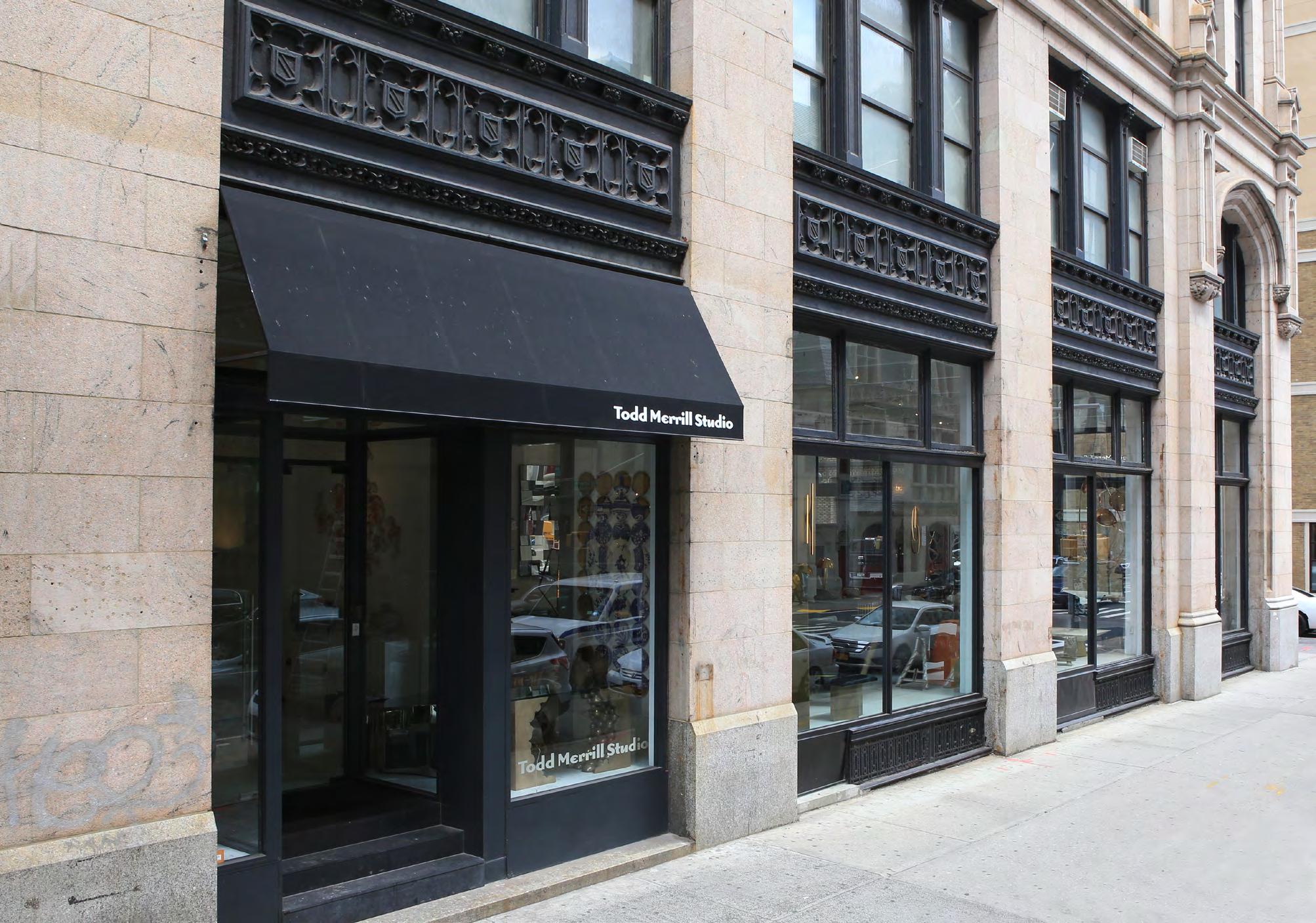


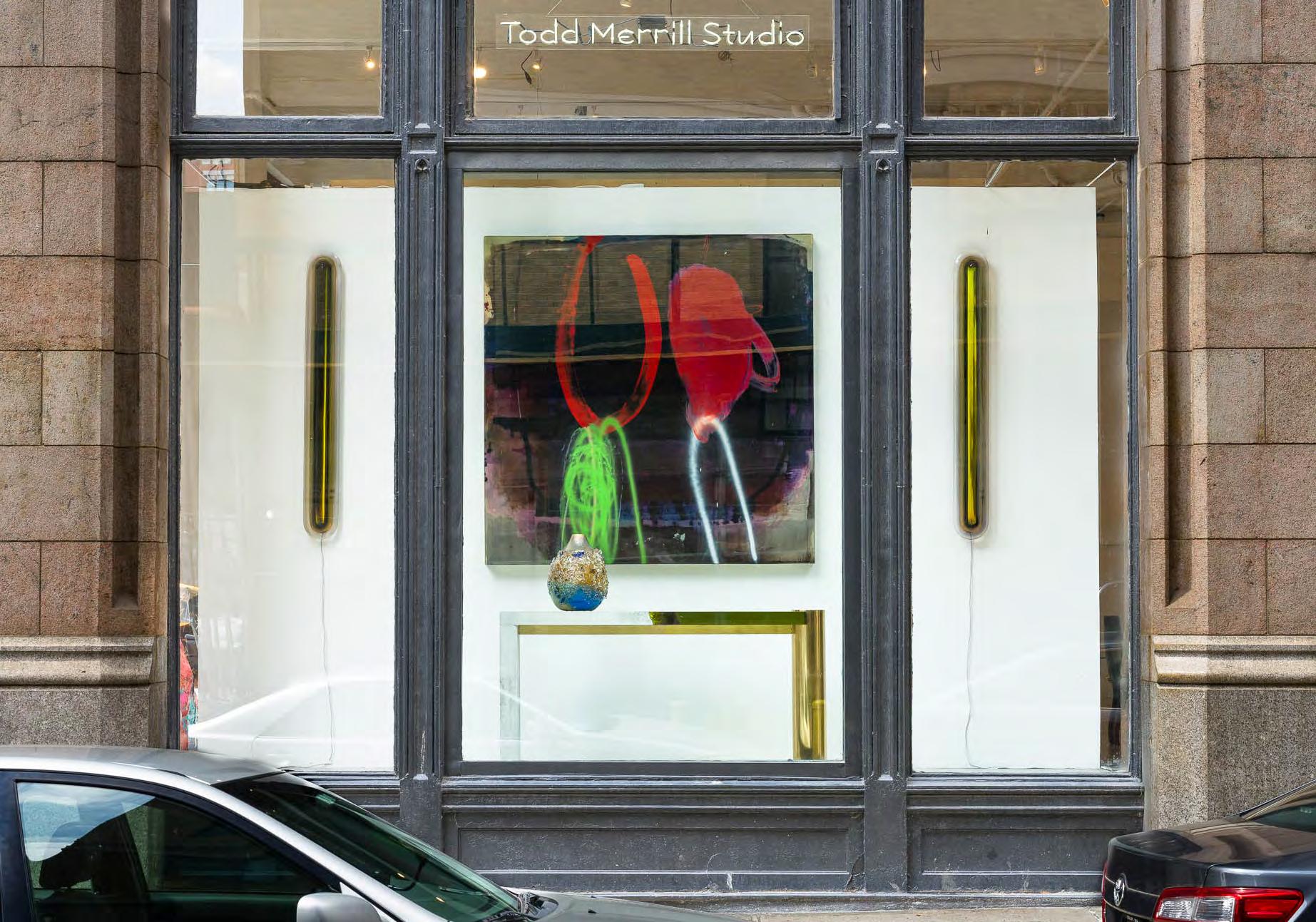
Copyright © 2024 Todd Merrill
All rights reserved. No part of this publication may be reproduced, distributed, or transmitted in any form or by any means, including photocopying, recording, or other electronic or mechanical methods, without the prior written permission of the publisher, except in the case of brief quotations embodied in critical reviews and certain other noncommercial uses permitted by copyright law. For permission requests, write to the publisher, addressed “Attention: Permissions Coordinator,” at the address below.
Todd Merrill & Associates, Inc.
80 Lafayette Street New York, NY 10013
www.toddmerrillstudio.com
Catalog Design: Dallas Dunn

JACK ROGERS HOPKINS (1920-2006)
YUNHWAN KIM
GARY MAGAKIS
ANDREA MARQUIS
JOHN PROCARIO
ERIK SPEER
Printed in the United States of America
DRAGA & AUREL
AUREL K. BASEDOW
GABRIEL CHARBIT
PIA MARIA RAEDER
ALEX ROSKIN
CHRISTOPHER RUSSELL
DJIVAN SCHAPIRA
MAARTEN VROLIJK
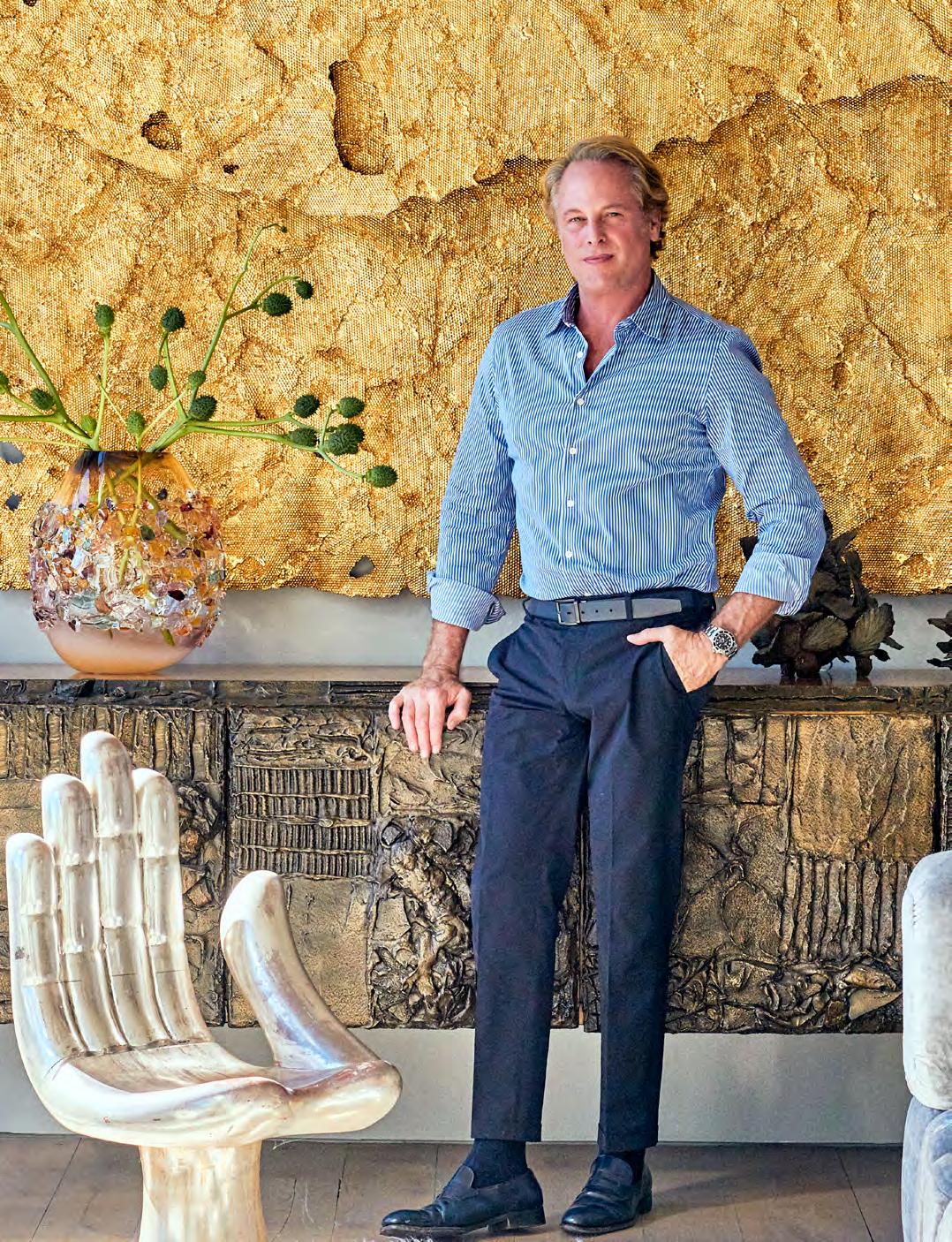
TODD MERRILL STUDIO
Todd Merrill Studio represents an international group of established and emerging artists, each with a singular artistic vision and unprecedented point of view. In creating unique works of collectible design, each artist takes a hands-on approach that intersects contemporary design, fine art, traditional craft techniques, and pioneering innovation.
Individually, through meticulous craftsmanship and rigorous studio experimentation, each has developed leading-edge, proprietary methods that break previously set inherent limitations of conventional materials like wood, metal, plaster, concrete, ceramics, glass, and resin. Their intimate studio approach fosters an atmosphere of creativity where the work rendered significantly bears the hand of the artist.
Collectively the artists are helping to create a new visual vocabulary that advances long-held, established artistic boundaries. Their dynamic, one-of-a-kind, and frequently groundbreaking works contribute to today’s increasingly relevant gray space between art and design.
With the gallery’s support, the artists’ works have entered the collections of major private and public patrons and prestigious museums including the Cooper Hewitt National Design Museum in New York; the Museum of Fine Arts in Boston; the Museum of Art and Design in New York; the High Museum in Atlanta; the Victoria and Albert Museum in London; the Carnegie Museum of Art in Philadelphia, the Houston Museum of Fine Art, and the Brooklyn Museum in New York.
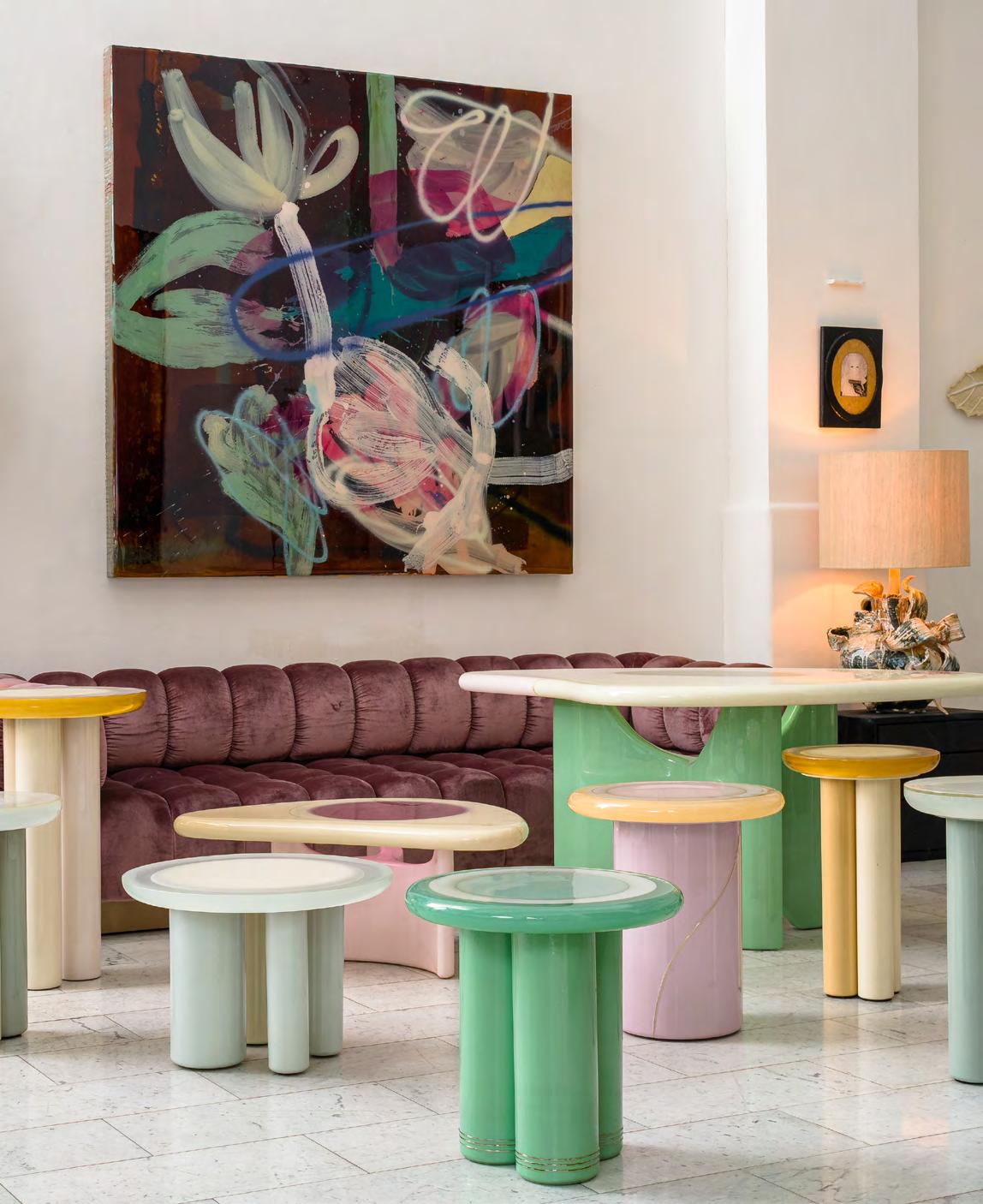
In 2000, Todd Merrill opened Todd Merrill Antiques which quickly became renowned for its glamorous and eclectic mix of twentieth-century furniture and lighting. The pioneering gallery was one of the of the first to promote modernist and postmodernist American studio artisans including Paul Evans, Phillip Lloyd Powell, George Nakashima, Karl Springer, James Mont, Tommi Parzinger, among others.
In 2008, Rizzoli published Merrill’s “Modern Americana: Studio Furniture from High Craft to High Glam”, the first ever authoritative examination of the great studio furniture makers and designers who, from 1940 thru the 1990s defined American high style. To celebrate the tenth anniversary, in 2018 Rizzoli published an expanded edition, adding 60 pages to his original book. This survey of the period continues with two massive additional chapters focused on Women Makers and Showrooms.
After the publication of Modern Americana in 2008, Merrill began to shift the mission of the gallery and started the Studio Contemporary program which has today become his primary focus.

80 Lafayette Street New York NY 10013
www.toddmerrillstudio.com
DRAGA & AUREL
Founded in 2007 in the town of Como, Italy, Draga & Aurel is a multi-disciplinary design studio that works along the spectrum of furniture, textile and interior design. Inspired by Minimalism’s simplified volumes and the eye-bending patterns of Optical Art, partners Draga Obradovic and Aurel Basedow have brilliantly synthesized these varied influences to build a cohesive collection called “Transparency Matters’, entirely fabricated by hand in their Como atelier. Interpreting the power of transparency to illuminate, delight, transform and distort, they have perfected the art of resin, achieving high strength, jewel-toned, crystal-clear furniture, lighting, and accessories.
Their latest collection, the Flare Series exclusive to Todd Merrill Studio, epitomizes the duo’s deep dive into the interplay of color and light refraction. Through a rigorous study of materials and their capacity to come alive with color and light, Draga & Aurel have created a material process that imitates internal illumination created as opposing colors react to ambient light . Their mastery in epoxy resin artistry is globally acknowledged, and in this project, they push their creative boundaries further by embracing Lucite. This acrylic material undergoes a painstaking process, with skilled artisans from Lake Como collaborating closely with the duo in their studio.

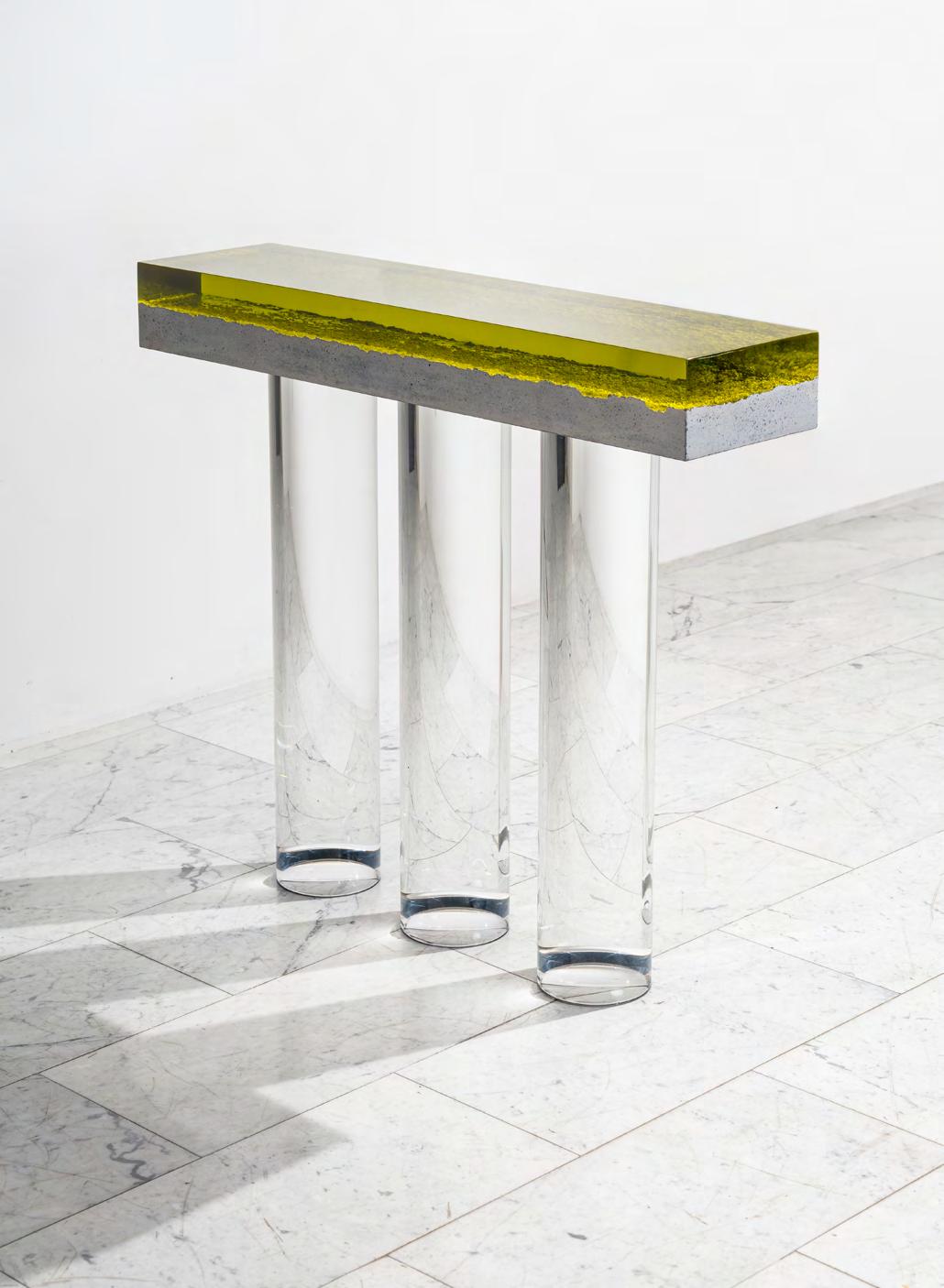 Lucite
Sizes vary
Lucite
Sizes vary

AUREL K. BASEDOW
Aurel K. Basedow, a prominent contemporary painter, channels emotion and energy through his enigmatic mixed-media artworks, demanding active engagement and emotional connection from viewers. Born in Munich in 1963, Basedow co-founded a successful design studio before rediscovering his passion for painting in 2015. Influenced by painters like Mark Rothko and Gerhard Richter, Basedow’s works balance chaos and control, employing mixed media and resin to create compositions of geometric lines and expressive brush strokes.
Basedow’s distinctive style incorporates a layering technique within hand-poured resin, using mediums like enamel, pastel, dyes, and spray paint to build dynamic, unpredictable compositions. The resin’s reflective surface adds depth and translucency, creating a dynamic interplay with light and environment. By concealing elements within layers of resin, Basedow invites viewers into a visual narrative, demanding emotional and visceral engagement over passive observation, exemplifying his innovative approach to contemporary painting.
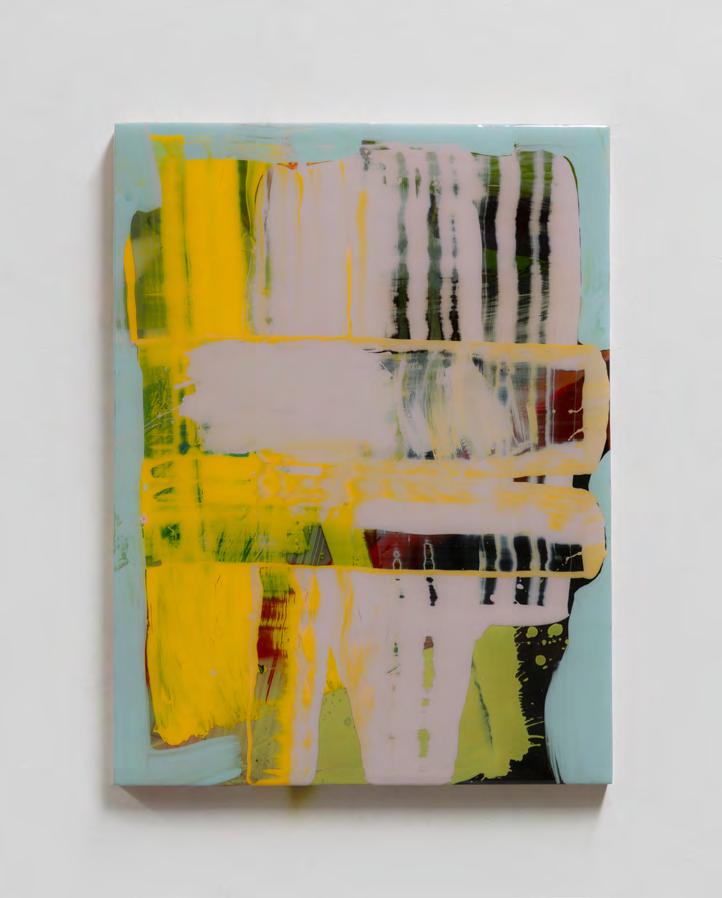

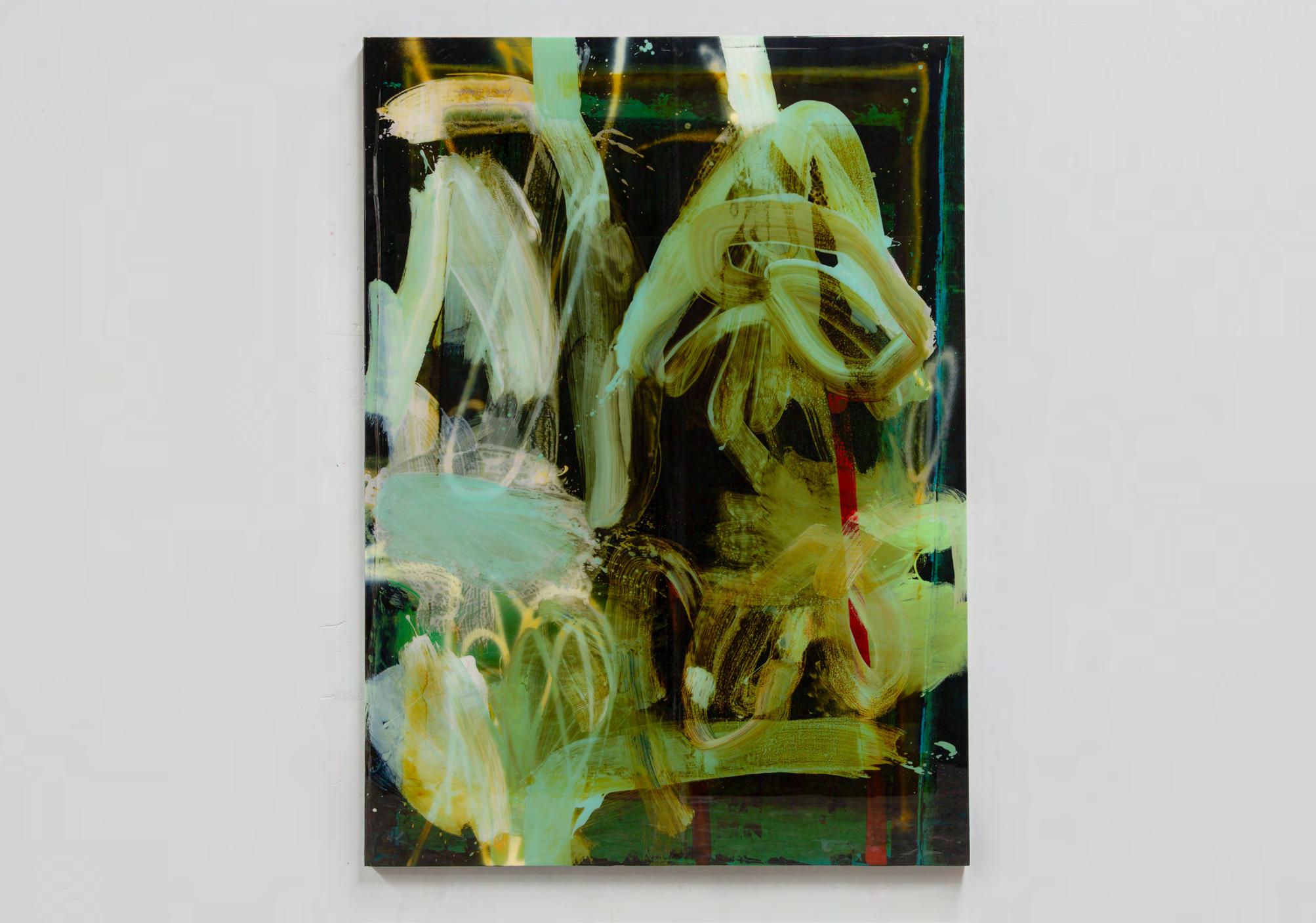
GABRIEL CHARBIT
Gabriel Charbit uses his keen observation skills to draw inspiration from his surroundings, nurturing abstract forms into physical realization. Driven by a passion for decontextualization, he finds fascination in landscapes, cultures, social norms, human characters, and behaviors, allowing each of these disparate qualities to coalesce into a singular abstract articulation.
His collection, “Metropolis,” was inspired by New York City’s iconic cityscape. Through Charbit’s lens the skyline of NYC is a magnificent product of the sum of its parts, with each building’s unique function becoming obsolete when viewed as the greater whole. Similarly Charbit’s aim for his designs is to transcend their traditional roles, inspiring a play between material textures and outside parameters such as light, space, and distance, ultimately leaving room for personal interpretation.
His FDR Mirror is, itself, an architectural marvel. Its mix of patinated steel, textured glass, and dark and light mirrors, combined with its structural clarity, is the perfect encapsulation of the often utilitarian beauty of New York’s myriad skyscrapers.
The Metropolis Collection includes desks, chairs, consoles, lighting, and room dividers

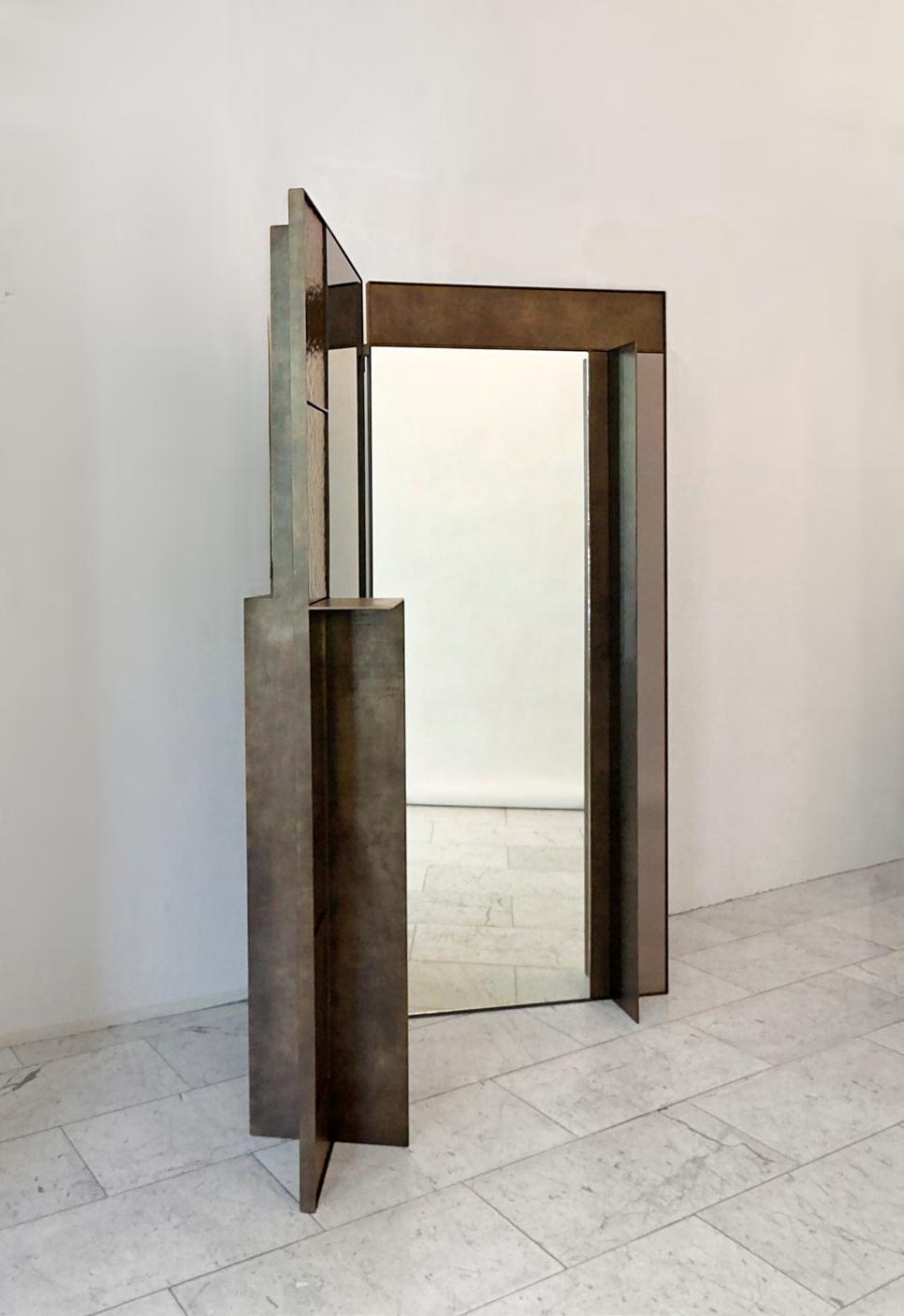

JACK ROGERS HOPKINS (1920-2006)
Jack Rogers Hopkins (1920-2006) was a pivotal figure in the California Studio Design Movement during the late 1960s, advocating for more sculptural, natural, and free-flowing forms in furniture. His laminated wood pieces often integrated multiple functional elements within singular designs, showcasing an almost otherworldly aesthetic.
Hopkins, recognized as a significant yet underrepresented member of this movement, shared similarities with Wendell Castle, utilizing adventurous woodworking techniques like stack lamination. Alongside his California contemporaries, Hopkins contributed to modernism with a Golden State sensibility that prioritized comfort and approachability. His works, featured prominently in exhibitions such as California Design Eleven (1971) at the Pacific Art Center in Pasadena and “Jack Rogers Hopkins, California Design Maverick” at the Sam Maloof Foundation, exemplify his futuristic style while emphasizing the intrinsic qualities of wood, as seen in pieces like the “Edition” Chair, characterized by swooping, aerodynamic lines. Hopkins’ “Edition Chair” was designed in 1969 with a limited edition of 5 produced between 1969 and 1971.
Hopkins is also featured prominently in “Modern Americana: Studio Furniture From High Craft to High Glam:, Rizzoli 2008/16.
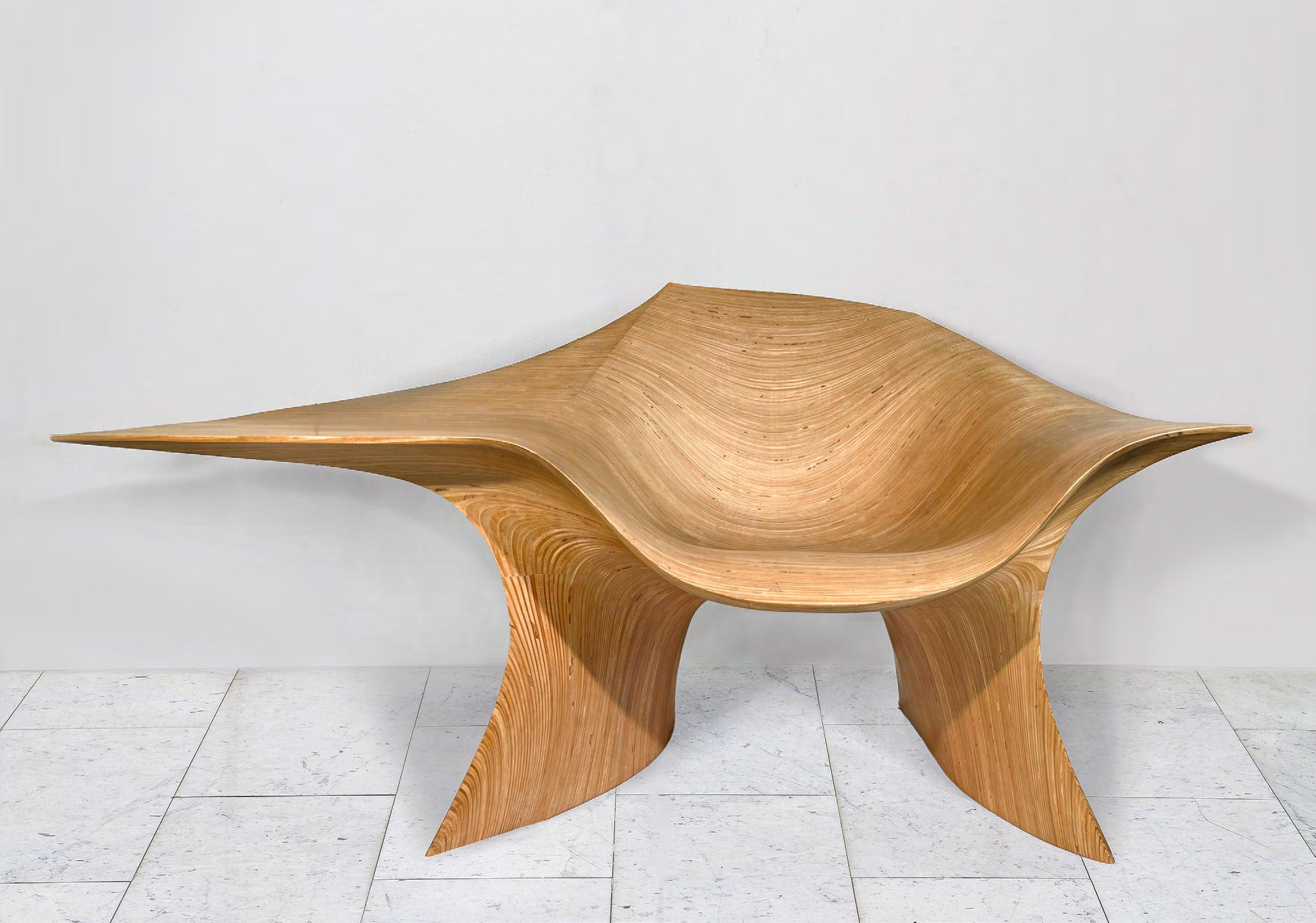
YUNHWAN KIM
In the past 5 years Korean artist Yun Hwan Kim has made a significant mark in the world of collectible design. His bronze “Unintended Console Table” continues his material exploration. With his distinctive line of works called the “Unintended Series,” which includes cabinets, tables, screens, mirrors, and lighting, Kim has captivated audiences with his remarkable craftsmanship and artistic vision. What sets Kim’s creations apart is their irregular, improvisational, and organic nature. His forms vaguely resemble the silhouette of spilled water, embodying a sense of fluidity and topography. Large contoured shapes define his pieces, interconnecting like tributaries or branch-like forms, creating an intricate and visually captivating composition. The fusion of these elements results in furniture that blurs the boundaries between function and art, challenging conventional notions of design. In his latest works, Kim has ventured beyond wood and started incorporating cast aluminum and bronze. By mimicking the hand-carved wood forms in these high-end materials, he has firmly established his presence in the contemporary realm. This exploration of new mediums and materials adds a layer of sophistication and experimentation to his art, pushing the boundaries of his creative expression.
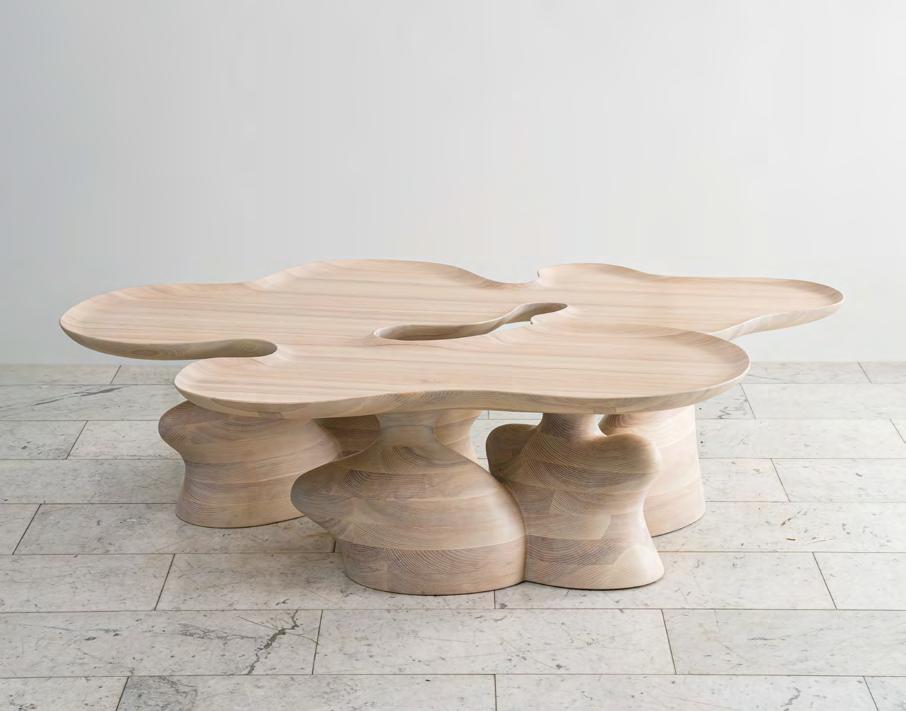

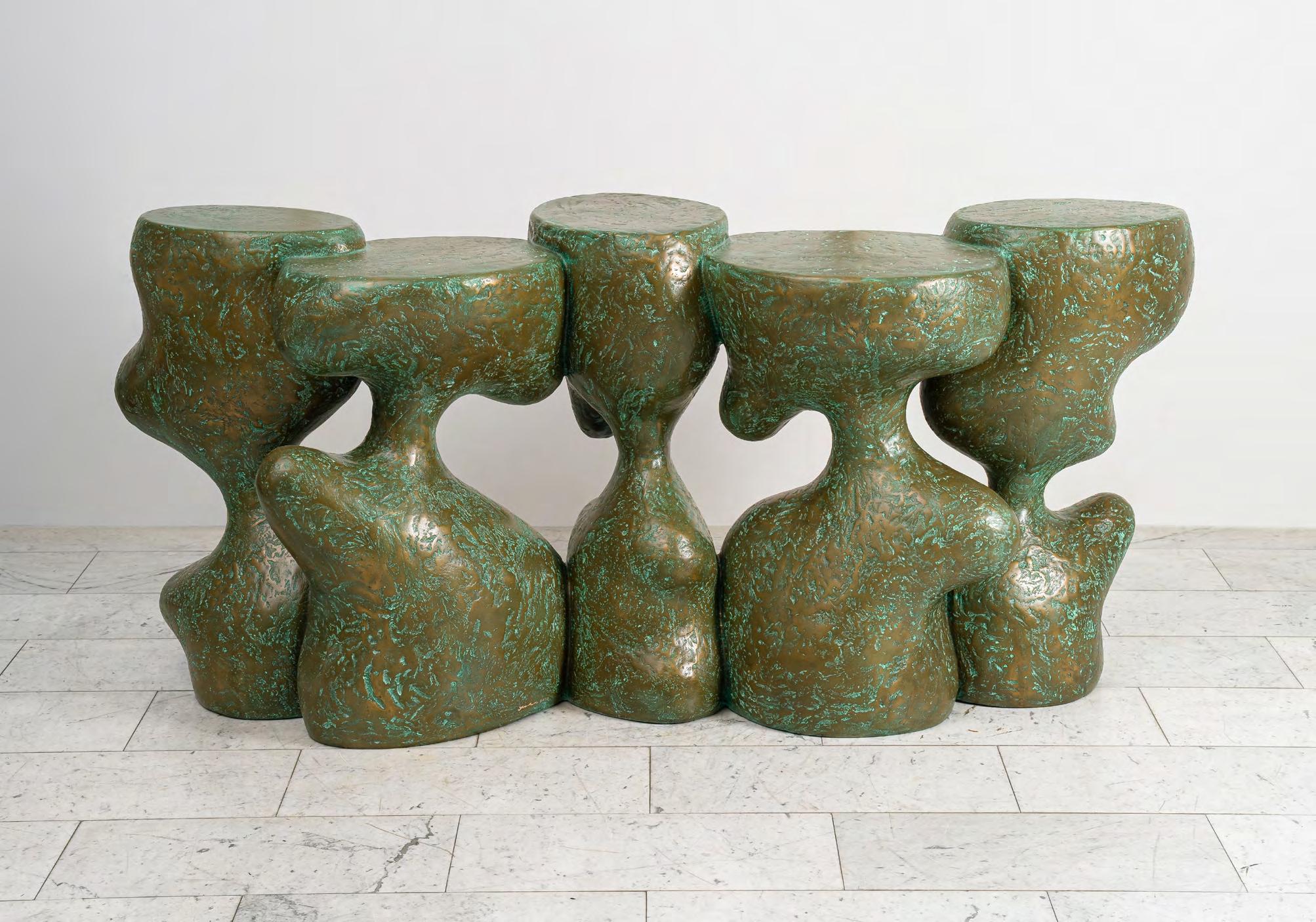
GARY MAGAKIS
Todd Merrill Studio has been the exclusive representative of Gary Magakis since 2013. Gary Magakis has built a cult-like following among top designers and collectors for his dynamic studio-driven metal furniture composed of seemingly simple geometric shapes.
When creating his bronze and steel sculptural furniture, Magakis looks to ancient metal arts, modern architecture, and the American Studio Craft Movement for inspiration. However, it is the work of Paul Evans that has left the most significant impression on Magakis. Evans’ unprecedented use of sculpted metal forms and patinated surfaces is reflected in Magakis’ Sculpted Metal series. Magakis’ distinct approach to design produces bold and dense geometric forms that exude a Modernist elegance and buoyancy. Magakis’ furniture is infused with a sense of place: his summer studio is a farm north of Scranton, Penn., at the foot of the Endless Mountains, and he attributes his fondness for cantilevered forms to Wright’s “Fallingwater,” in the southwestern corner of the state.
Magakis received a degree in sculpture from Penn State and studied welding under the instruction of sculptor Klaus Ihlenfeld, Harry Bertoia’s former assistant.

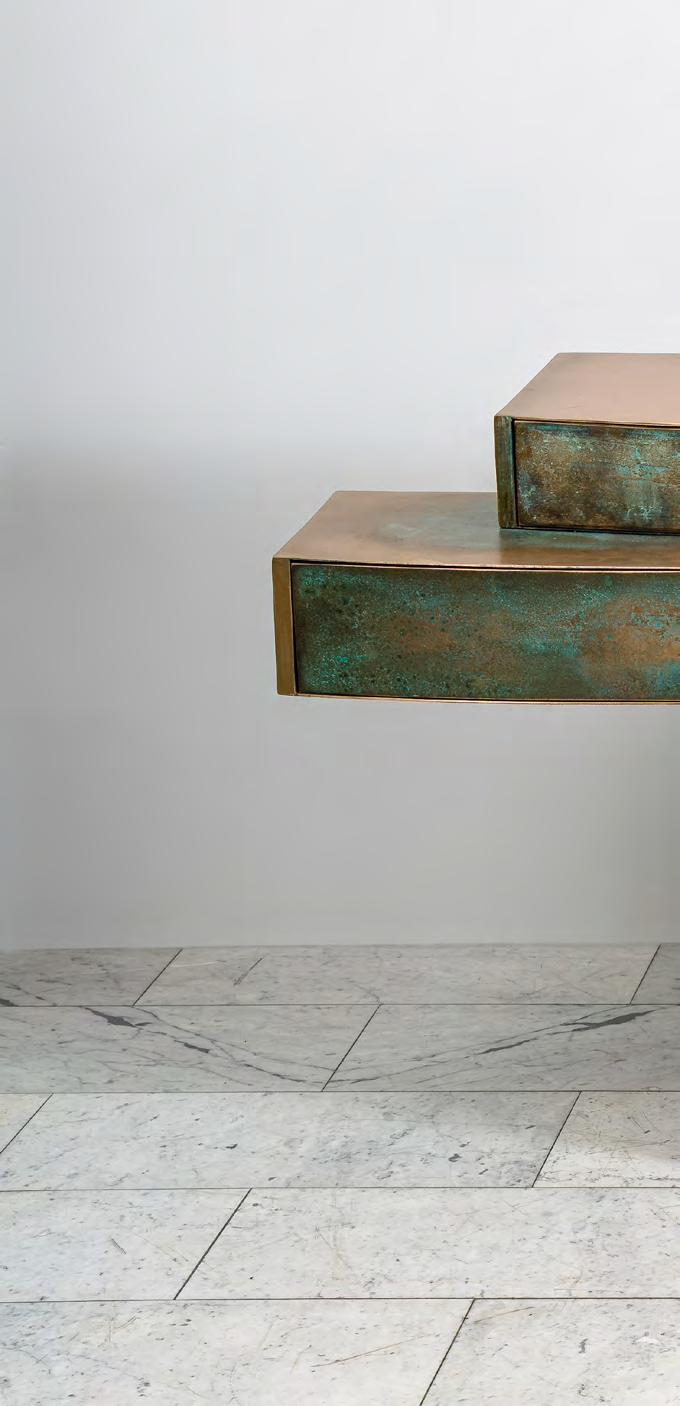

ANDREA MARQUIS
Andrea Marquis, renowned for her technique of pushing visual and technical boundaries, her artistic practice centers on challenging the substance and value of decoration against the function of sculpture. Vacillating between utility and pure aesthetics, her work possesses an abstract quality that encourages subjective interpretation.
For over a decade, Marquis has been working with clay, fashioning tangible embodiments of shadows, reflections, traces, imprints, boundaries, and apertures. Taking a nod from architecture, she transforms thick slabs of clay into gravity-defying forms that are both lacy and robust. The compositions for her sculptures begin as traced drawings of plant shadows, often grown in her own garden. These layered composite drawings surround her in her studio, becoming a lexicon of image fragments. Through deliberate manipulation and experimentation with various compositions, Marquis skillfully pivots and reconfigures her traced drawings, evoking a Rorschach-like harmony. Her use of loosely applied glazes softens the sharpness of her cut edges, imparting an element of fluidity to the overall composition. While Marquis approaches her artistic practice with clear intentions and a well-defined vision, she enthusiastically embraces the creative imagination and varied interpretations elicited by her work.

JOHN PROCARIO
For over a decade John Procario has continued to produce elegant, contemporary, and minimalistic designs that capture viewers emotionally through sensation and observation.
Having grown up around his carpenter father’s workshop, Procario entered the world of art and design with a well defined love of woodworking and a distinct vision inspired by his reverence for the material’s possibilities and limitations. Procario has developed a unique aesthetic that began with the notion of wood as metaphor for the human body. “I would describe my work as having a heartbeat,” says Procario. “Each one has so much personality. As you move around them, the forms appear to shift and change. Just as we push the limits of our bones and muscles, I enjoy pushing the limits of wood to create a sense of strain in the material’s gesture,” Procario further elaborates. By pushing the limit of breakage, Procario creates a sense of strain in the otherwise fluid gestures of his works. Conceptually, this reveals beauty to be the product of stress. The outcome is an organic, fluid design balanced with a sense of motion.

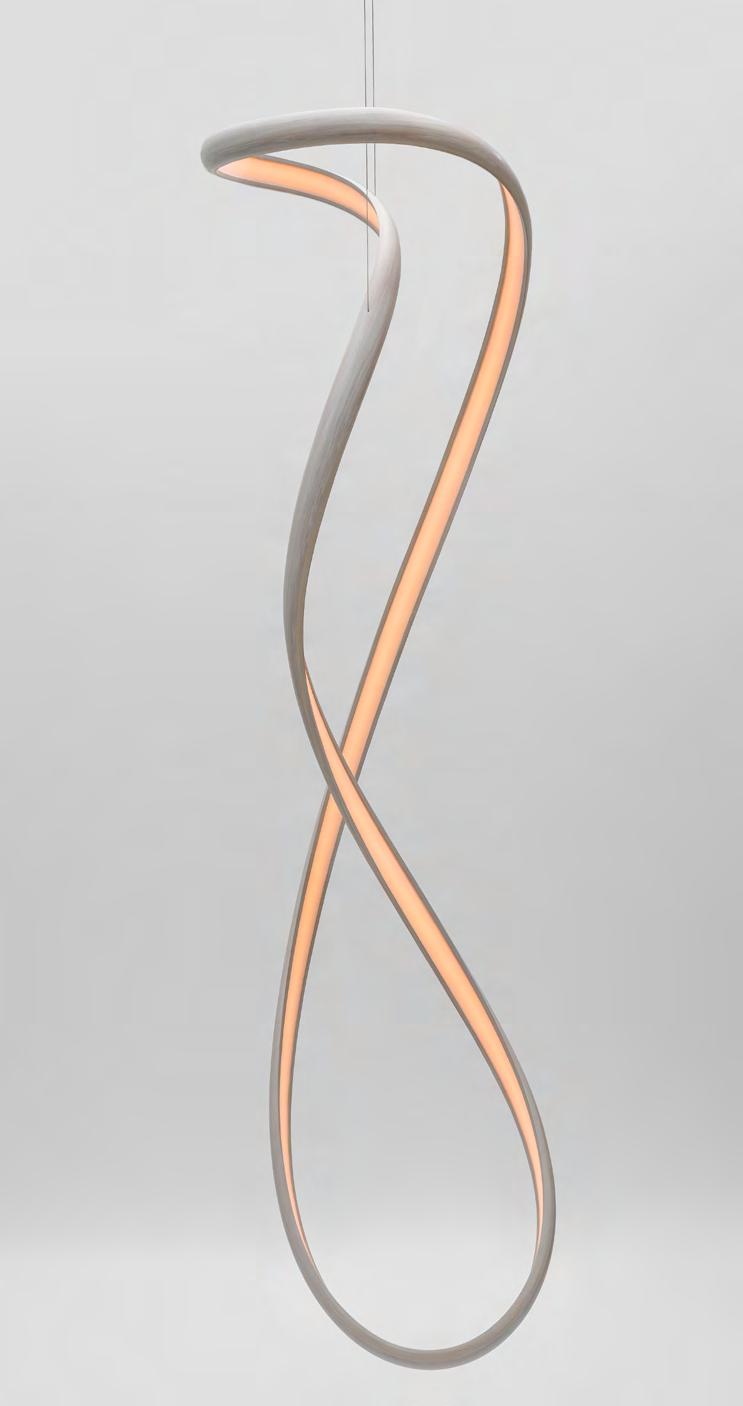 Ash, gesso & white oil, LEDs, linen diffuser 20h x 90w x 41d inches
Ash, gesso & white oil, LEDs, linen diffuser 20h x 90w x 41d inches

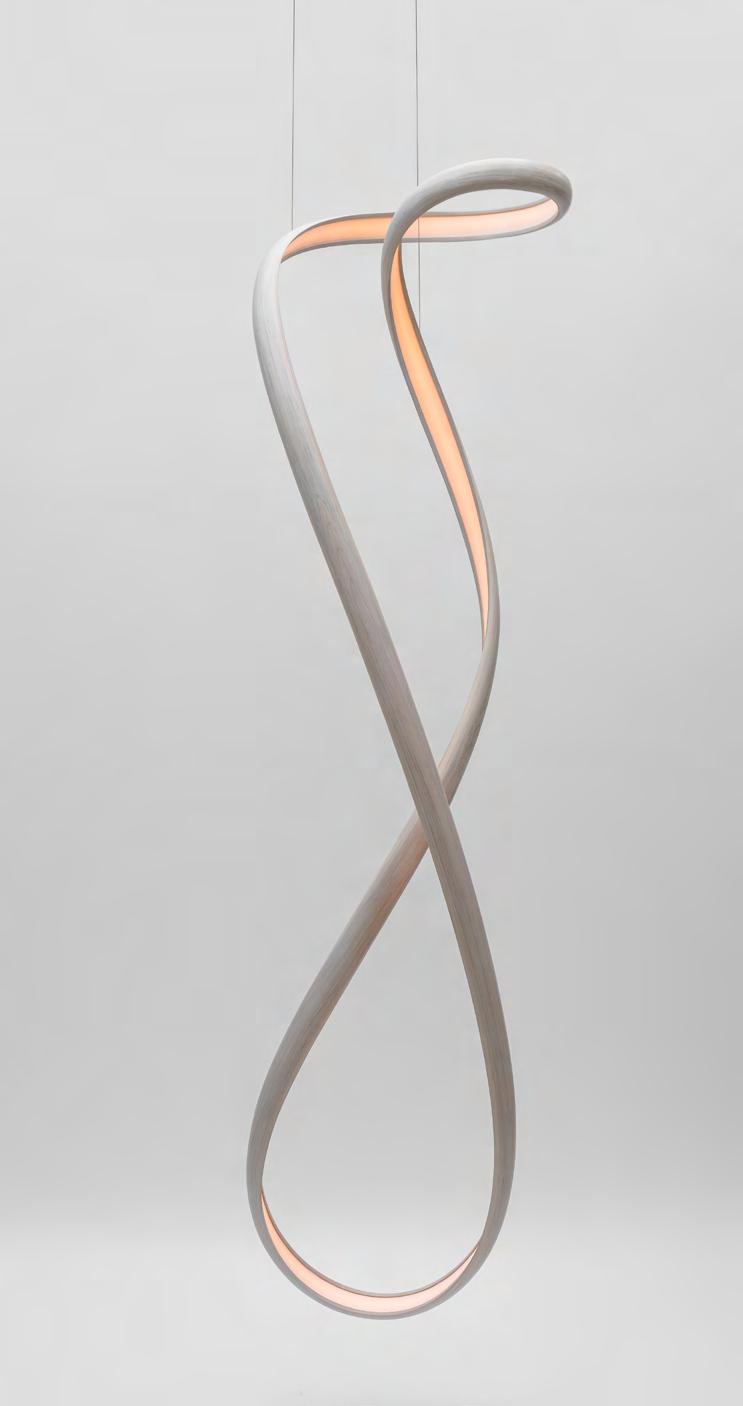
PIA-MARIA RAEDER
Pia Maria Raeder is dedicated to expressing her unique vision of nature by translating its aesthetic wonders into sculptural pieces. Inspired by organic structures, her practice fosters emotional and tactile engagement, aiming to create vibrant and surprising artworks that resonate with viewers.
Her work has earned global recognition, including a place in the permanent collection of the Musée des Arts Décoratifs in Paris, France. In 2021, Raeder was selected by the House of Dior as one of 12 international women artists to reimagine the ‘Miss Dior’ bottle.
Raeder’s acclaimed ‘Sea Anemone’ series captures the ocean’s beauty, crafted from thousands of meticulously arranged beechwood rods. Liberated from its original form, the wood transforms into undulating shapes that seem infused with life, echoing nature’s essence. Each piece reflects Raeder’s abstract interpretation of nature’s allure and fragility, exemplifying her meticulous craftsmanship and biomorphic style. Through intensive creative processes, like those used in the Sea Anemone collection, Raeder’s sculptures come to life, offering homage to the sea’s treasures.

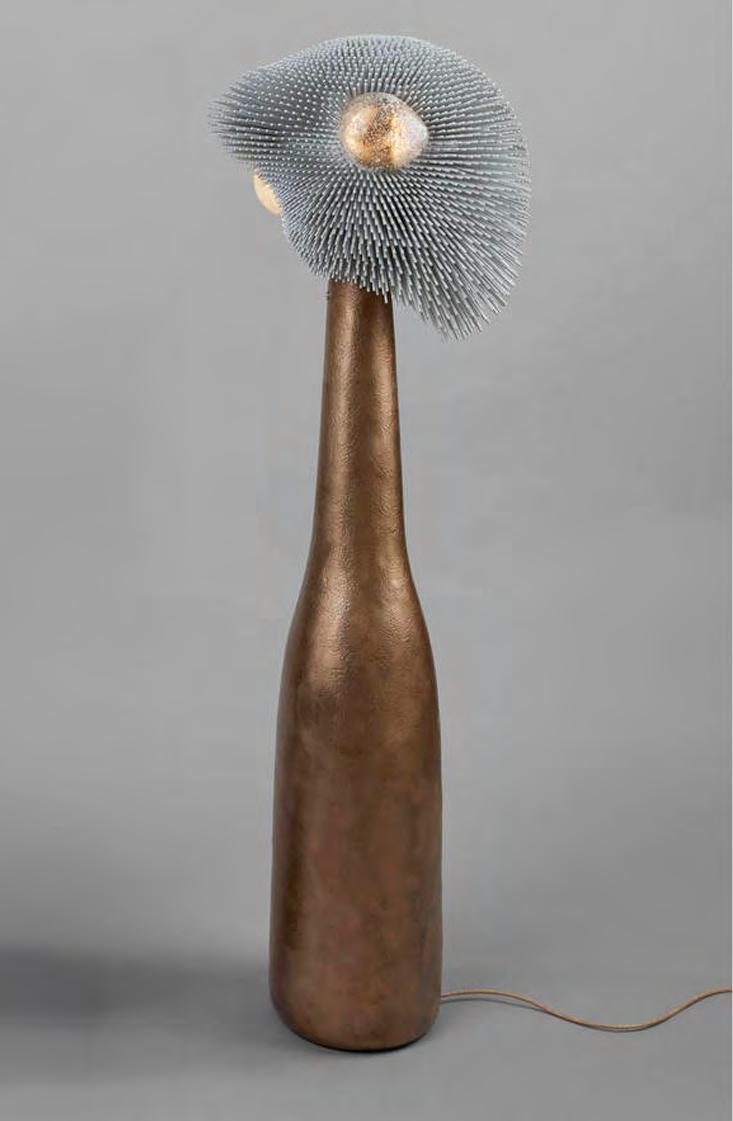

ALEX ROSKIN
Alex Roskin’s Tusk Chair exemplifies his inclination towards animalistic forms. Crafted from mirror-polished stainless steel, the chair boasts a low seat and broad back, harmonizing masculine and feminine qualities through active, potent, and playful shapes. Roskin imbues each piece with a sense of dynamism, as though frozen in a moment of vitality; the chair’s front legs gracefully bow outward while the hand-carved back legs ensure each creation is one-of-a-kind.
Roskin’s creations marry practical design with nods to modernist sculpture. Drawing inspiration from influential artists like Richard Serra, Jean Arp, and Constantin Brancusi, Roskin employs cast bronze, stainless steel, and carved wood to convey modernist and primitive influences.
His chairs embody a mammalian physicality, featuring sinuous forms and gracefully bowed legs, suitable for diverse uses—from salon and desk chairs to dining sets— polished or rubbed patina bronze, polished or blackened stainless steel, polished aluminum or aluminum with a range of faux bronze finishes.

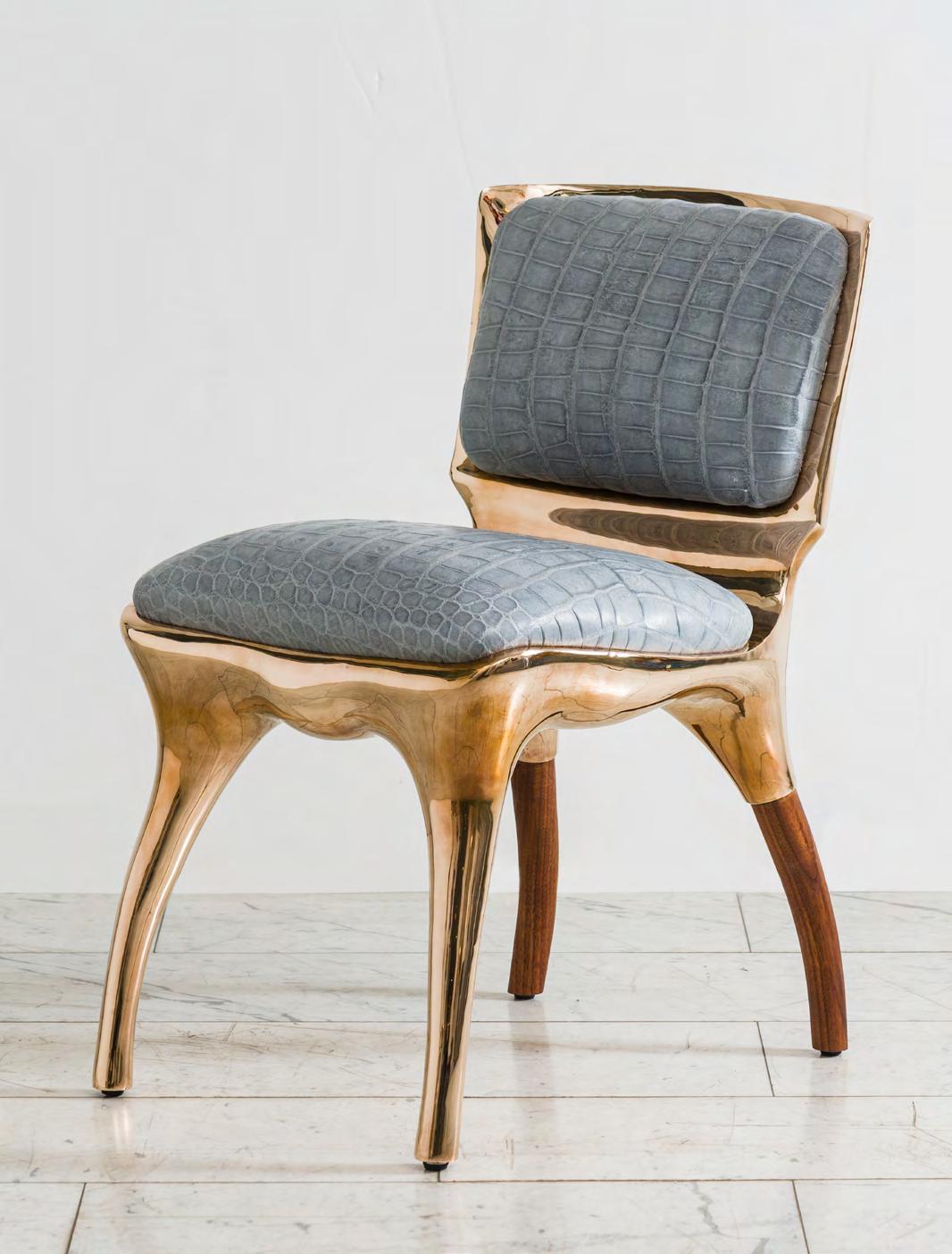
ALEX ROSKIN & JOHN PROCARIO
The collaborative sculpture “Anthropose” by John Procario and Alex Roskin stands as a monumental work of art, marrying Procario’s expertise in bent wood with Roskin’s mastery of bronze sculptural furniture. Standing over 7 feet tall, the sculpture harmoniously combines wood, bronze, and LED technology, embodying its essence through a human-like stance that invites viewers to discern subtle echoes of movement and gesture within its curvilinear contours. Procario’s contribution, a sinuous ribbon of blackened bent wood, is accentuated by hidden LEDs, casting dynamic shadows and illuminating the sculpture with a warm glow. Roskin’s signature trunk-like bronze base anchors the piece, revealing a polished interior that adds depth and elegance to the sculpture’s overall presence.
The commanding presence of their collaborative masterpiece is a testament to the transformative power of artistic collaboration and the boundless possibilities of creative expression. With its seamless blend of wood, bronze, and light, this sculpture serves as a captivating reminder of the enduring beauty and complexity of the artistic process.
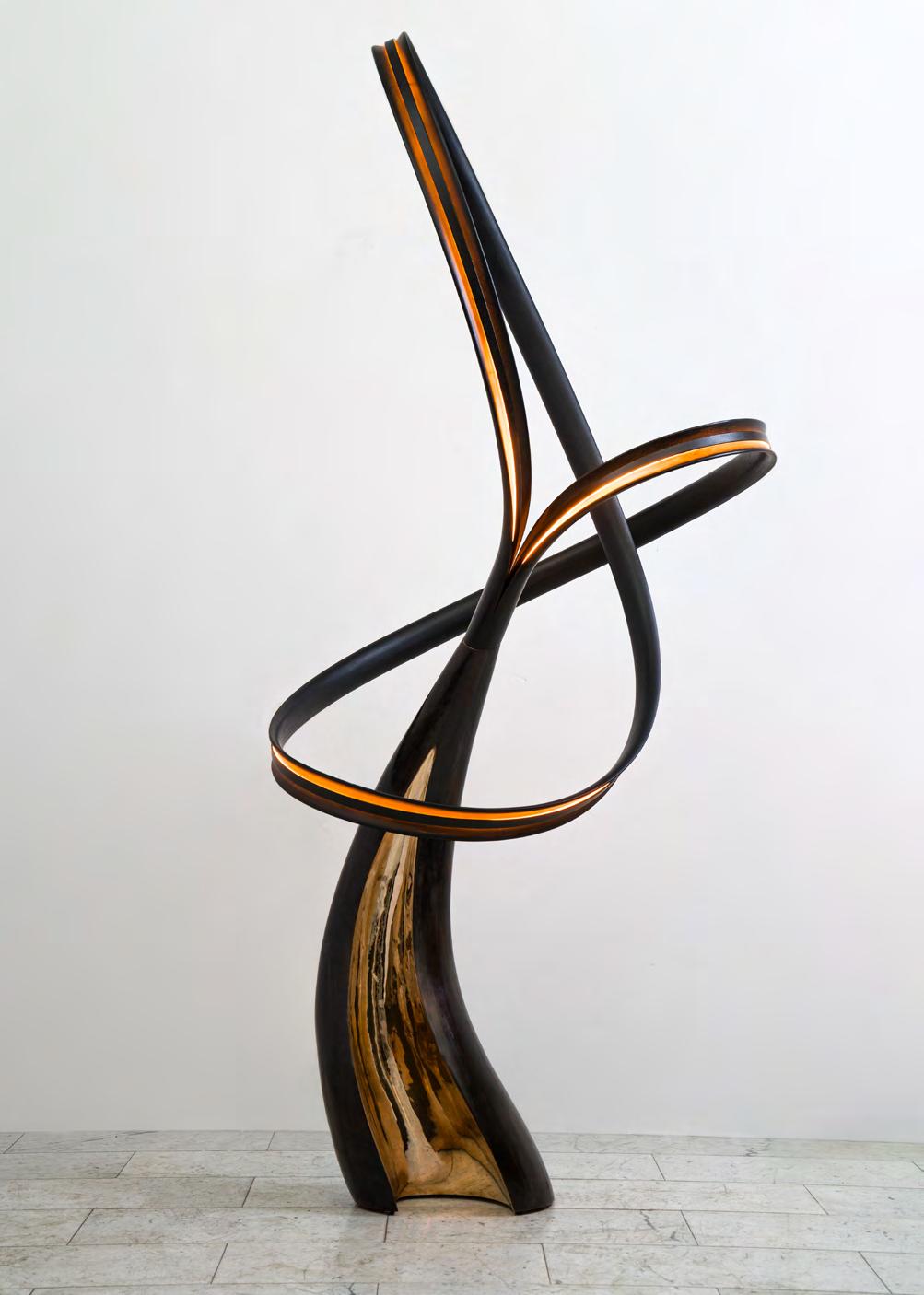
CHRISTOPHER RUSSELL
Christopher Russell, a New York City artist with over 30 years of experience, has dedicated his career to exploring clay as his primary medium, transitioning from painting and drawing to the versatile world of ceramics. His latest works, crafted through hand-building techniques influenced by his familial ties to architecture and engineering, exhibit a dynamic blend of structure and decoration. Russell’s vessels, while appearing meticulously planned with their geometric rigidity, are often created through spontaneous processes. Notably, his recent pieces feature vibrant surface ornamentation, characterized by patchworks of shapes in a range of colors, applied with precision using individually developed glazes and techniques like stencil resists and sgraffito, offering depth and complexity.
The hallmark of Russell’s art lies in the textured surfaces that invite tactile engagement, as he believes texture imbues ceramic pieces with physical vitality. His creations showcase a fusion of functionality and aesthetics, exploring the intersection of form, color, and design through a diverse palette of textures and patterns. Through his enduring fascination with clay, Russell continues to push boundaries, embracing the intrinsic qualities of his chosen medium to create works that captivate both the eye and the hand.

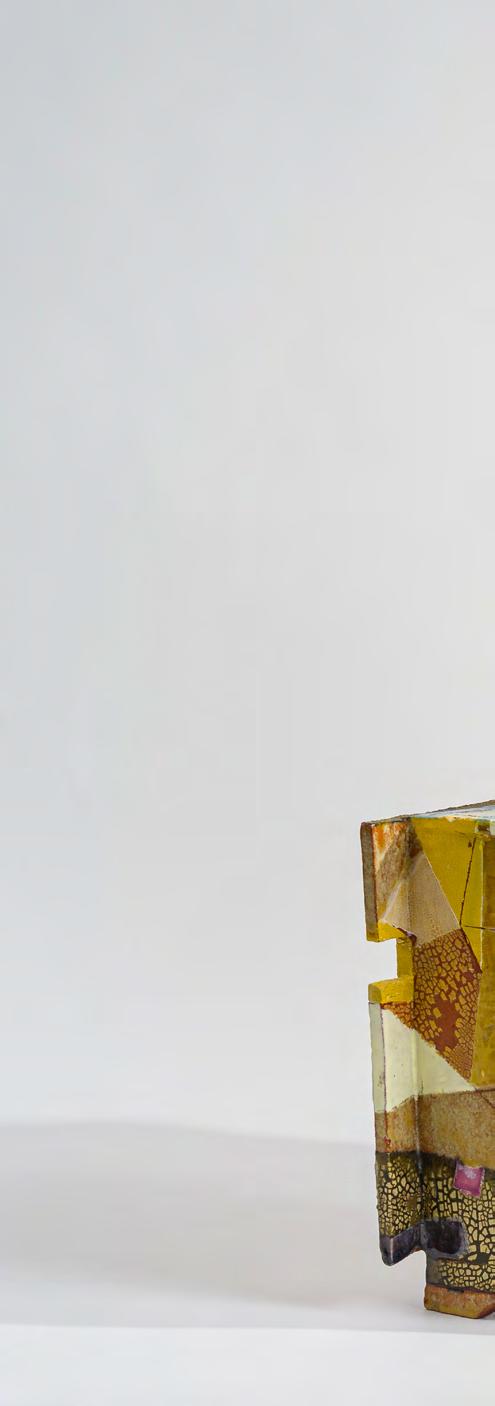
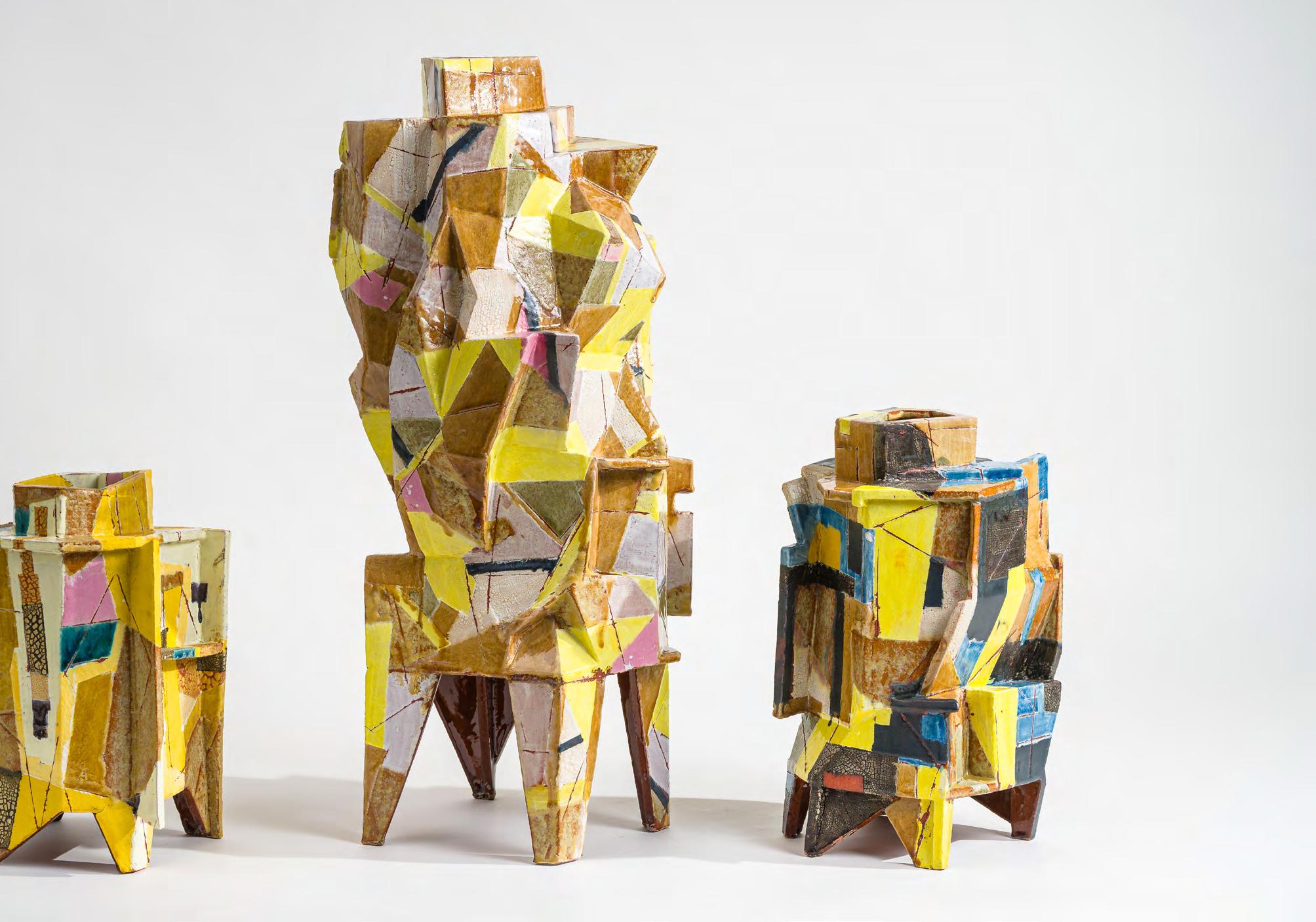
DJIVAN SCHAPIRA
The son of a master craftsman, Djivan Schapira developed an advanced woodworking practice over the course of 15 years as an apprentice cabinet maker. In his early 20s, he began experimenting with resins, developing techniques and a distinct style that would become the cornerstone of his artistic output.
His Orbit Occasional Tables marry visual motifs of retro futurism and highend French decorative arts techniques (marquetry, lacquer) learned from his father. Each is customizable in size, transparency, and a full spectrum of colors, The possibilities for combinations, arrangements, and colors of the resin are endless, rendering each piece completely unique.
His works have been placed in numerous private and public spaces, and can be seen in Louis Vuitton flagship stores globally, as well as hotels and casinos such as the Waldorf Astoria and the Venetian Hotel in Las Vegas. Schapira’s work has been featured in world-renowned publications including Interior Design Magazine, Architectural Digest, Modern Luxury, and Surface Magazine. In addition to winning an internationally acclaimed A’ Design Award for his Andromeda Cocktail Table in 2019, Schapira was the winning recipient of both the NYCxDESIGN 2022 Emerging Product Designer of the Year Award in the Furniture category, as well as the People’s Choice Award which crossed all mediums. In 2023 took home the prize for Best Furniture Design at NYCxDESIGN 2023.

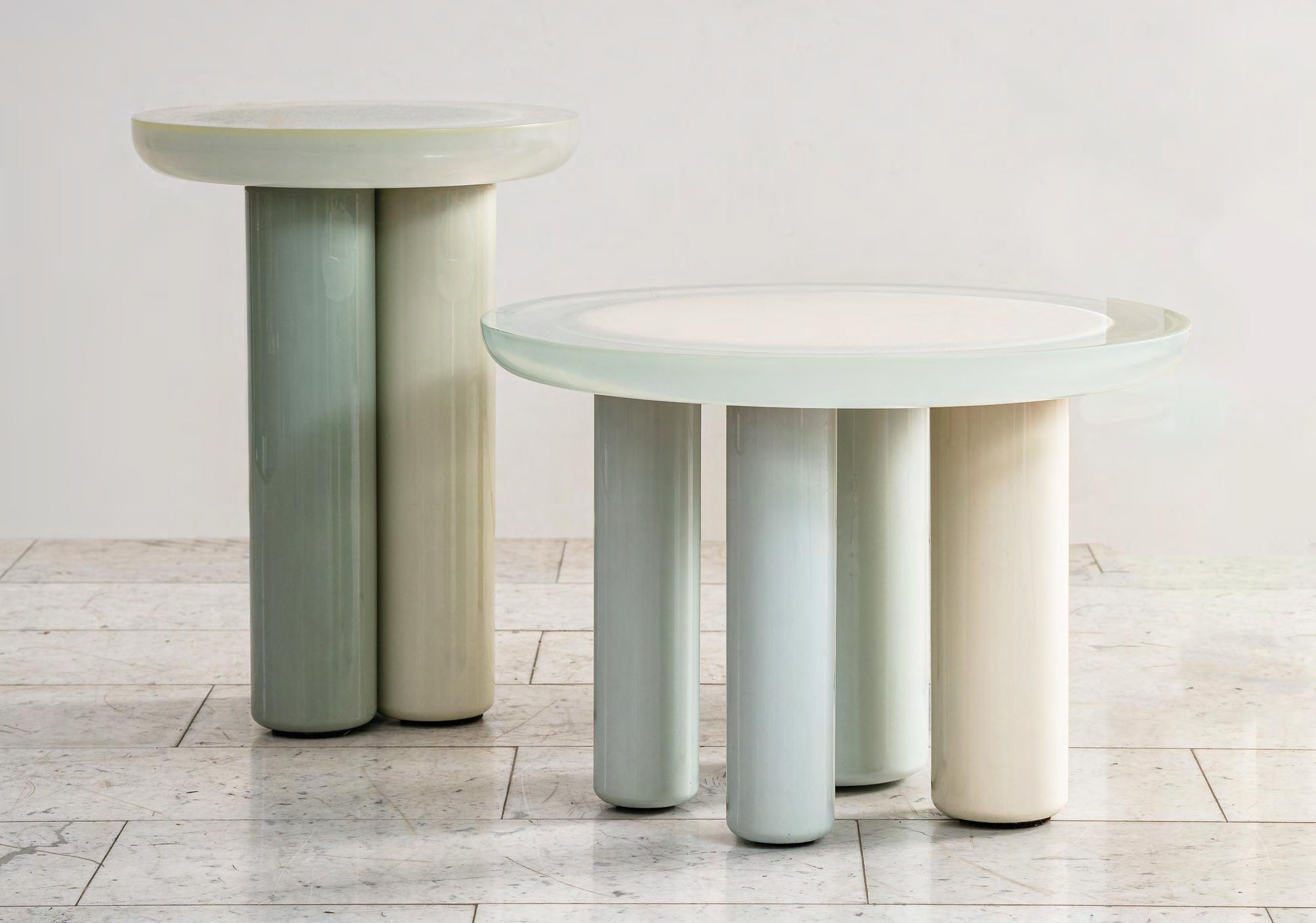
ERIK SPEER
Over the past eight years, nomadic artist Erik Speer has been crafting experimental fiber art collages using various techniques such as macrame, crochet, knitting, felting, and weaving. Rooted in his personal narrative and deeply expressive, his sculptural “tapestries” reflect his lifelong fascination with the ocean, which began when he moved to South Carolina as a teenager and explored marine life. After studying marine biology in college, he realized that a conventional office job wouldn’t fulfill him, leading him to become a diving instructor and travel the world. Eventually, he moved to New York City to study fashion design but found his passion in fiber arts. Inspired by his diving experiences, Speer uses natural materials like wool, silk, and linen, striving to incorporate recycled fibers and deadstock materials in his work. His art reflects the beauty and complexity of underwater landscapes, resembling coral reefs and sea creatures. Through his creative process, Speer finds meditative calm, akin to the underwater spaces that have always captivated him.

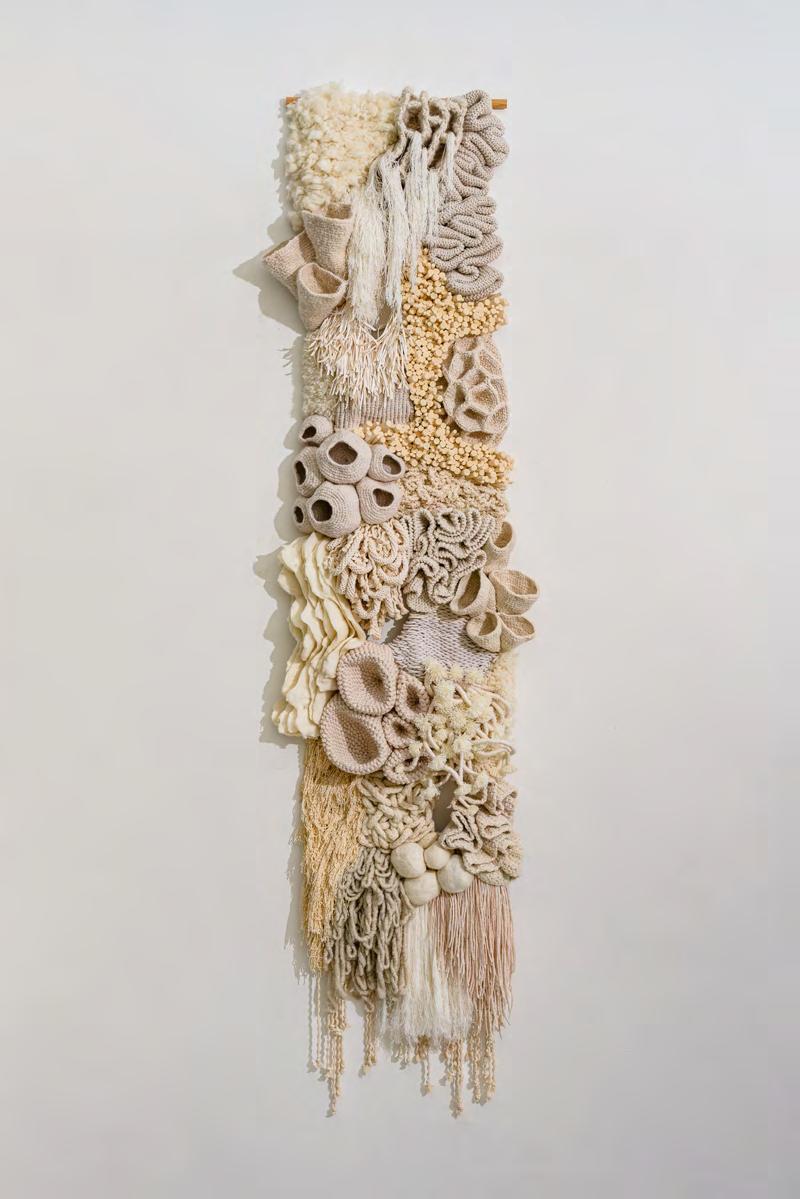

MAARTEN VROLIJK
Amsterdam-based artist and designer Maarten Vrolijk believes that art should make people’s everyday lives more beautiful through the many little details that evoke the unexpected. While strongly influenced by the natural world, Vrolijk is not on a quest to expose an imitation of the “real” world, but rather, is on an exploration of the simple, unequivocal, and often overlooked aspects: color, form, delicacy, strength, transparency, ephemerality, that provide a map to the fascinations we gravitate to when experiencing the world around us. The volatility in accomplishing the exceptional thickness of his glass vases creates a risky balance between strength and delicacy. The thermal stress caused when trying to equalize the interior and exterior temperature of the cooling vessels, is fraught with the propensity for breakage. The success of Vrolijk’s works lie in the crystalline clarity posed against their substantial physical impact.

Glass Sizes Vary

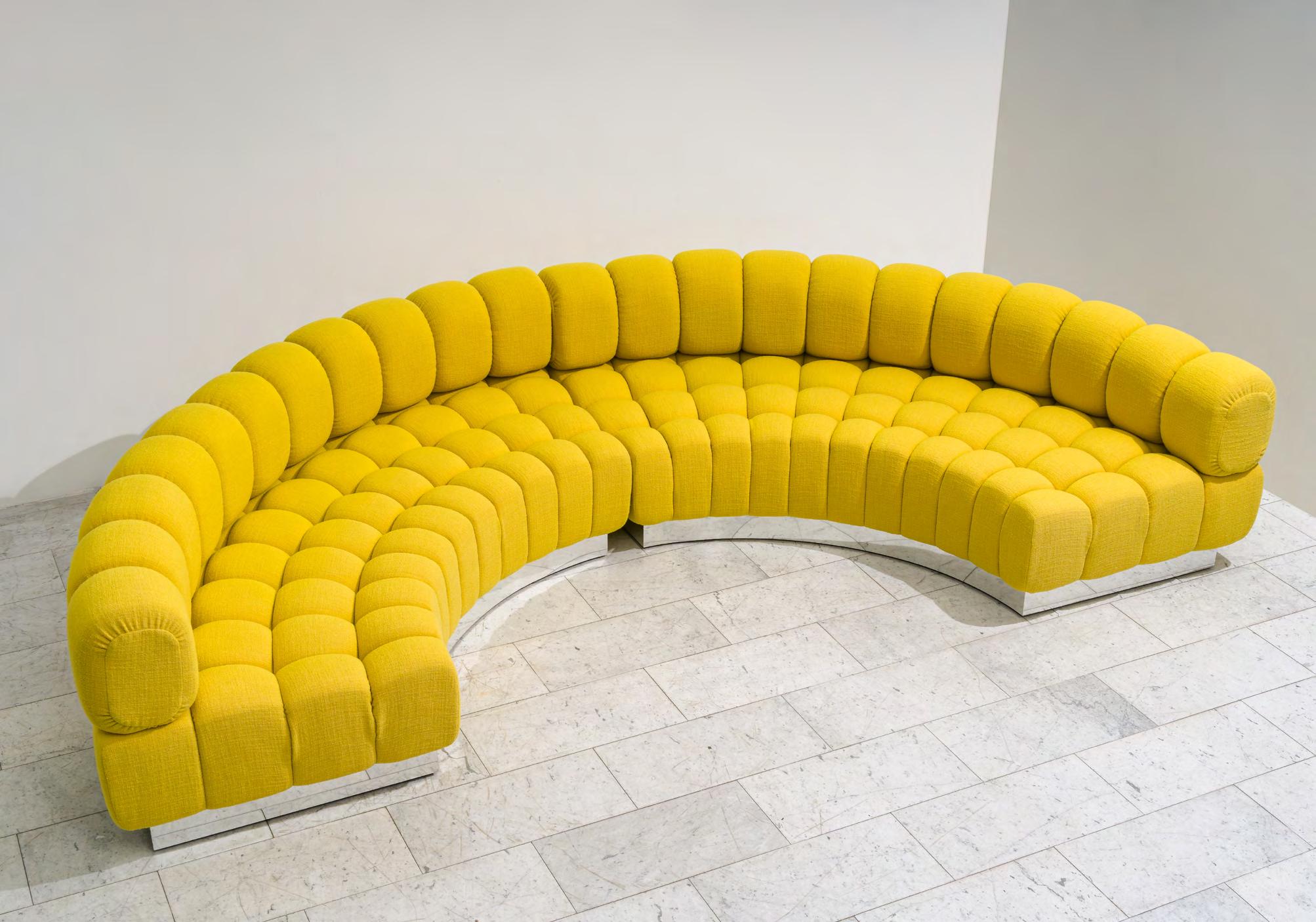
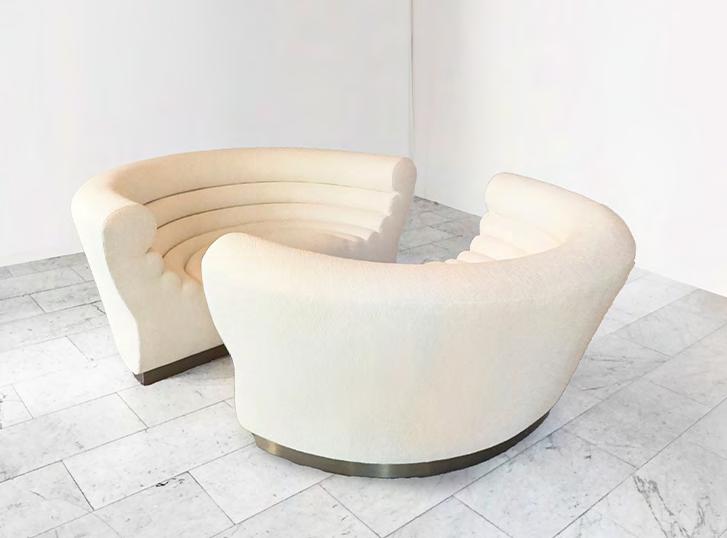
CUSTOM ORIGINALS
In 2008, Todd Merrill Studio introduced Custom Originals, a line of bespoke furniture including sofas, sectionals, chairs, and ottomans. Designed for both residential and commercial spaces, the complete line of Custom Originals is crafted locally in New York with Merrill personally overseeing production.
Proportioned for today’s lifestyle with a focus on comfort and generous scale, Merrill’s designs include the Tufted Series, the Channel Tufted Racetrack Sofa and Sugar Bowl Settee.
Merrill works with his clients’ architectural plans and elevations to propose the ideal forms and dimensions to create site-specific furniture tailored to the environment. As each piece is made-toorder, dimensions, finishing, and hardware may be altered to fit your needs.
All orders are COM, allowing you to decide nearly all aspects of the sofa.

CHECKLIST
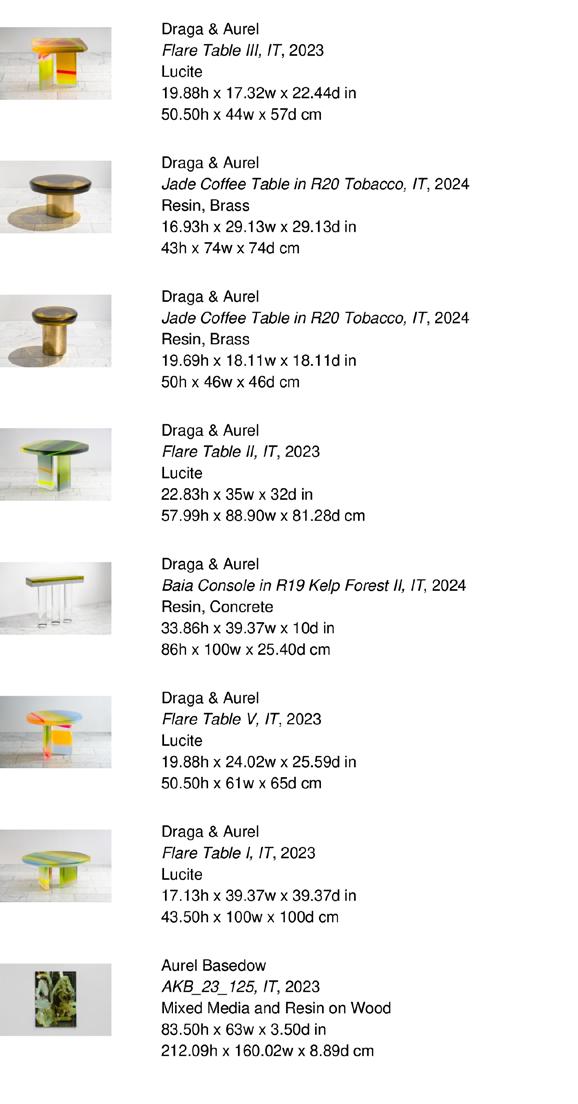
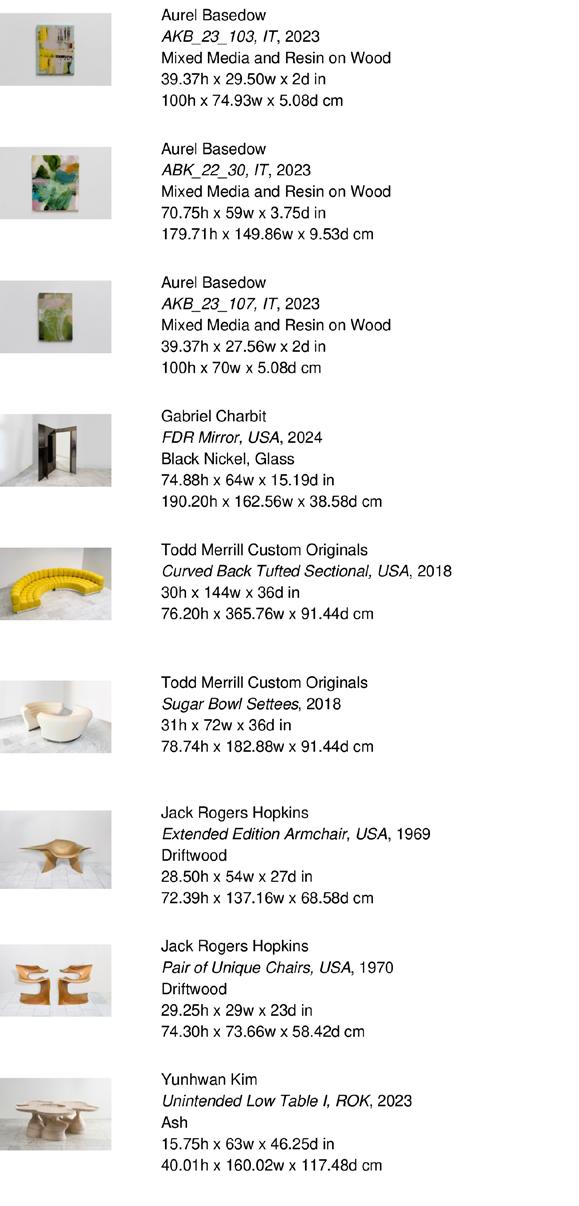
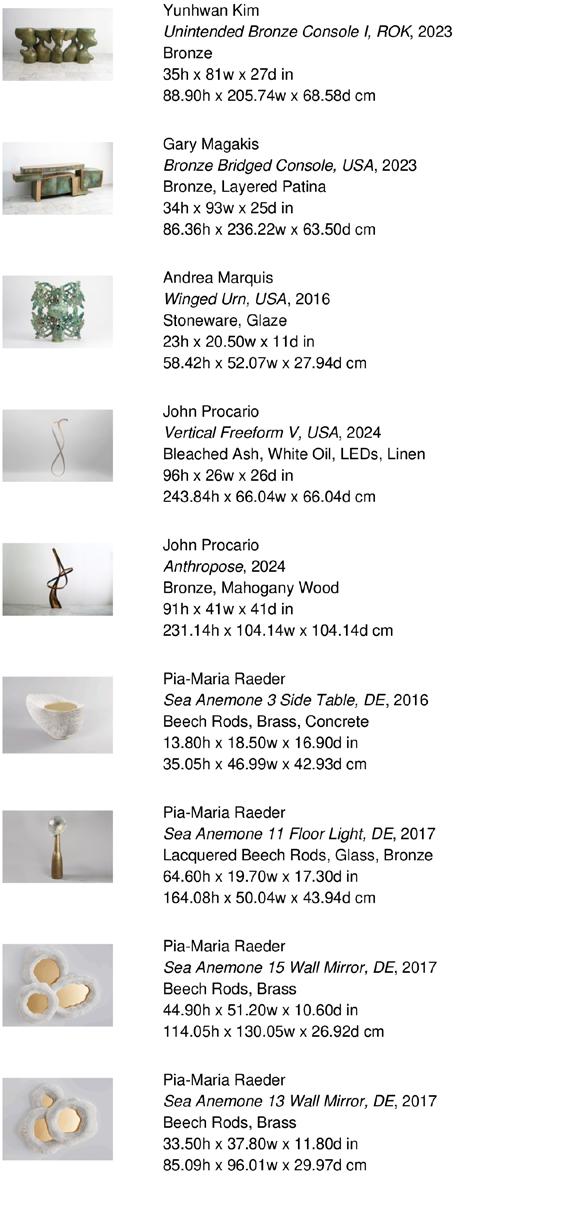
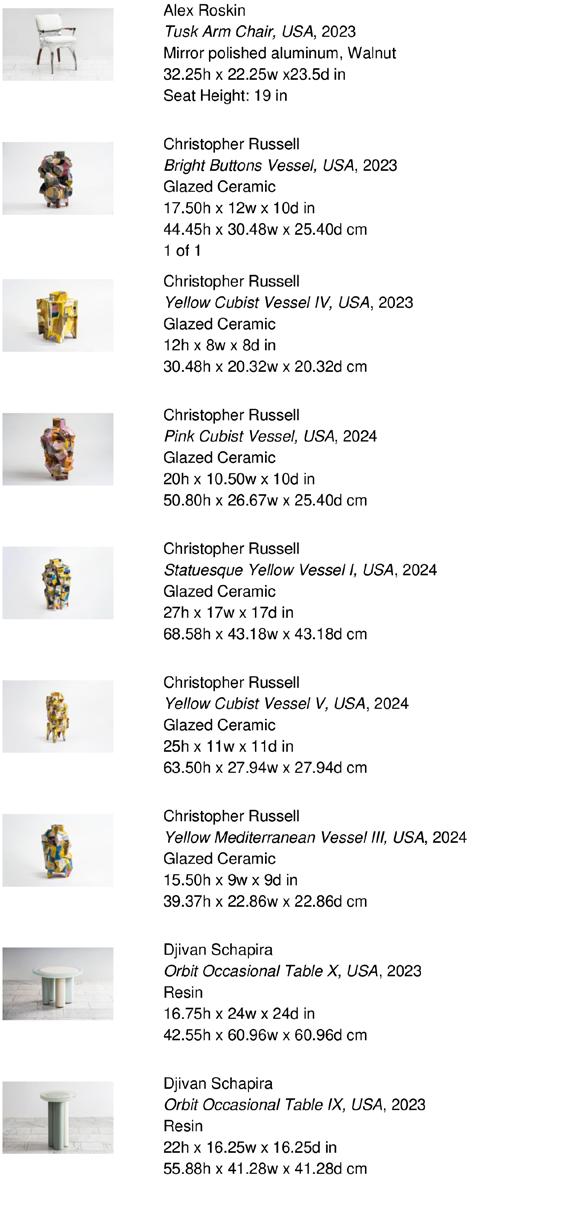
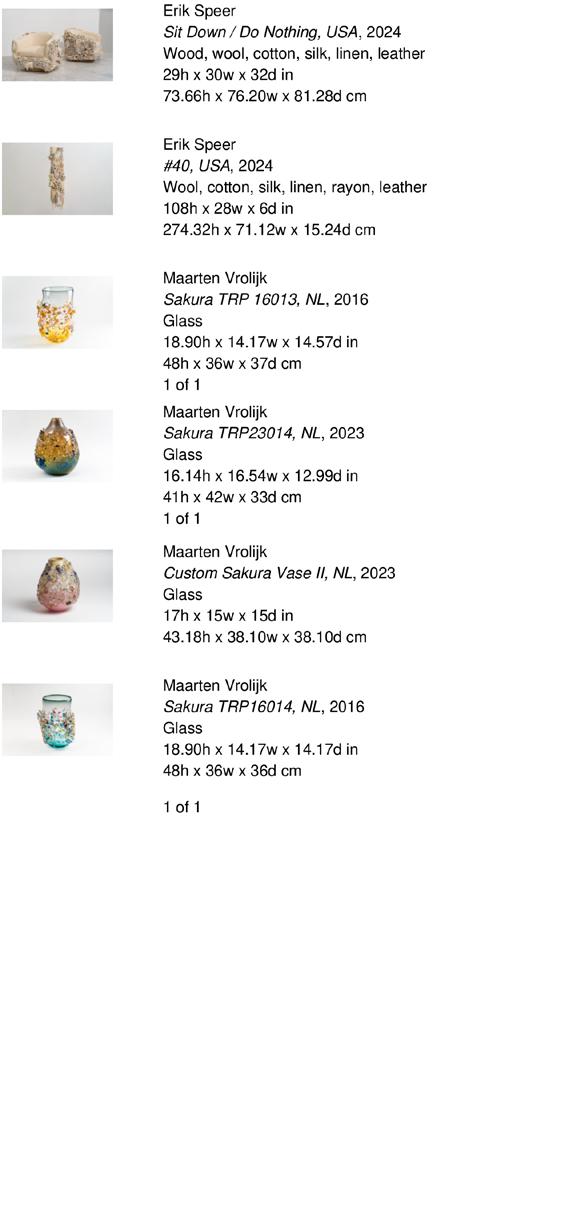
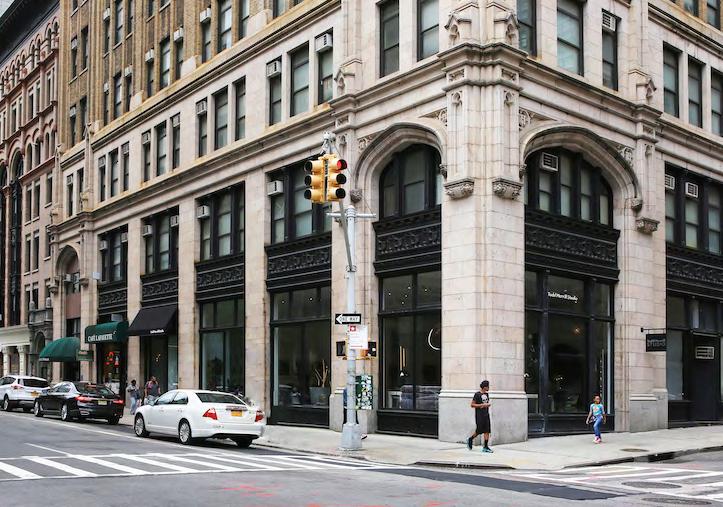











 Lucite
Sizes vary
Lucite
Sizes vary
















 Ash, gesso & white oil, LEDs, linen diffuser 20h x 90w x 41d inches
Ash, gesso & white oil, LEDs, linen diffuser 20h x 90w x 41d inches



























